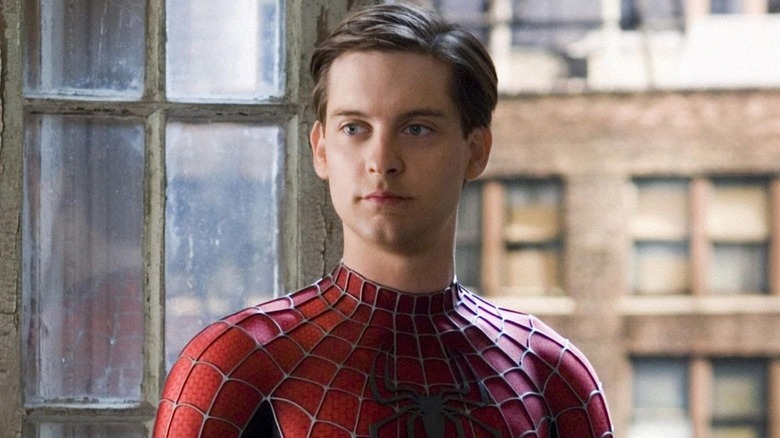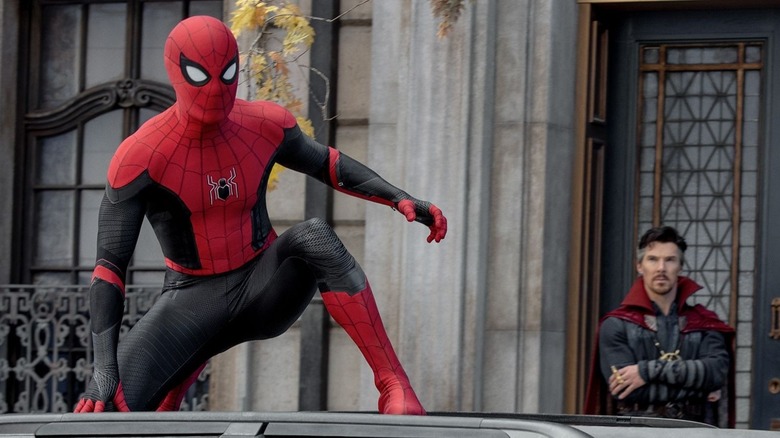Why It Took 17 Years To Get Spider-Man On The Big Screen
At the end of this year, Tom Holland will be seen in "Spider-Man: No Way Home," the anticipated conclusion to his film trilogy (the first one, anyway). When he debuted as the friendly, web-slinging neighborhood superhero in 2016, Holland played a small role in "Captain America: Civil War" before bagging his own superhero movie franchise. Since his cameo, the 25-year-old actor has reprised his role five times, which is more than both Tobey Maguire and Andrew Garfield.
Tobey Maguire, who played the first big-screen Spidey starred in three films from Sam Raimi, is often regarded as the best "Spider-Man" actor. Though Maguire was in no way the right age for the role, he left no stone unturned in convincing us that he was great as Peter Parker/Spider-Man. I was all but five years old when I saw him at the movies, but I grew up watching Maguire as Spidey, so I'm probably biased when I say he's my favorite.
But as beloved as Maguire now is in the role, it was a long path to getting him on the screen in that red and blue spandex. In fact, it took 17 years to get the original "Spider-Man" trilogy on the big screen.
Movie Rights Caused A Massive Delay
Bringing the Marvel Comics superhero to the big screen was no easy feat. In 1985, not many studios were interested in superhero movies. Cannon Films (the production company known for "Cyborg" and "American Ninja") spent a reported $250,000 to license the character from Marvel, for a period of five years. The deal included a deadline too, so if Cannon Films failed to make the movie by April 1990, the rights would return to Marvel Studios.
The cult film production company came up with a 50-page script that touched upon the plan for their "Spider-Man" movie, but nothing really worked out. After multiple failed script attempts, producer Menahem Golan of Cannon moved the rights to 21st Century Films. Six years later, that deal had also folded, and Carolco Pictures picked up the rights and held it until 1995, after which they went bankrupt.
You'd think studios were wrestling over rights for "Spider-Man," which has made Marvel and Sony billions of dollars today ... but nope. The rights to the film continued to fluctuate from studio to studio, and finally landed at MGM.
Marvel then filed a suit claiming they owned the rights since the Carolco deal expired in 1996, before MGM decided to put a film in the works. It was also then discovered that 21st Century Film once sold rights pertaining to their home video and television releases to Columbia and Viacom respectively.
After a court dismissed MGM's claim to Spider-Man in 1999, the web-spinning superhero finally found a home, for real this time! Sam Raimi then went on to introduce the hero through his 2002 film, "Spider-Man," thanks to a new deal struck with Sony Pictures, released via Columbia Pictures.
The film starred Maguire as Peter Parker/Spider-Man, Kirsten Dunst as Mary Jane Watson, William Dafoe as Green Goblin, and James Franco as Harry Osborn. "Spider-Man: No Way Home" has been surrounded by rumors stating that Maguire and Garfield will reprise their iterations of the hero in the chaotic multiverse teased by the trailer, but we'll only know when the movie releases on December 16. I'm trying (and failing) not to keep my hopes up.
At least there's the return of Alfred Molina (Doctor Octopus) and William Dafoe's Green Goblin to look forward to!

